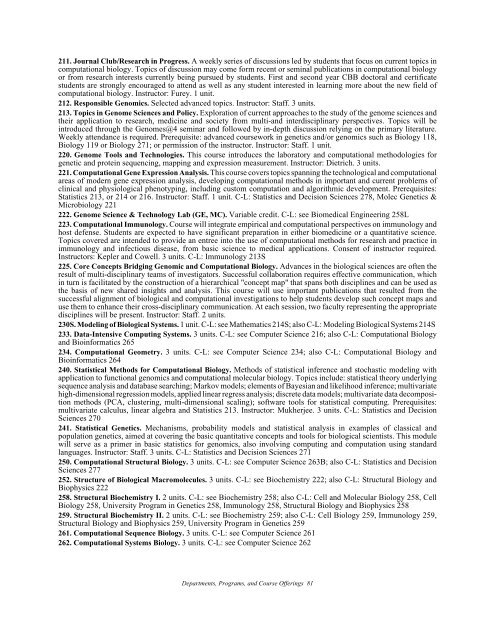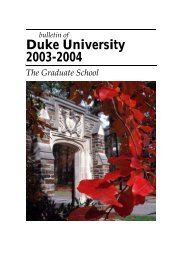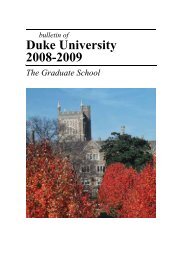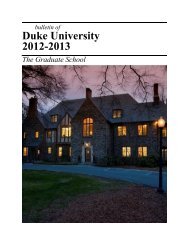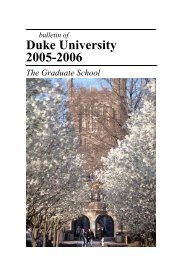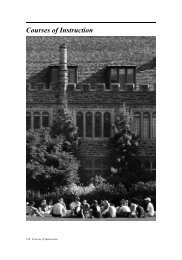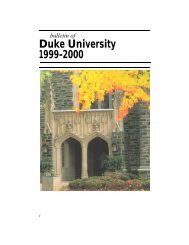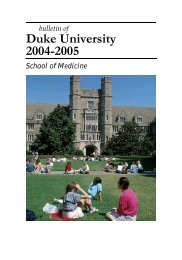Duke University 2009-2010 - Office of the Registrar - Duke University
Duke University 2009-2010 - Office of the Registrar - Duke University
Duke University 2009-2010 - Office of the Registrar - Duke University
You also want an ePaper? Increase the reach of your titles
YUMPU automatically turns print PDFs into web optimized ePapers that Google loves.
211. Journal Club/Research in Progress. A weekly series <strong>of</strong> discussions led by students that focus on current topics in<br />
computational biology. Topics <strong>of</strong> discussion may come form recent or seminal publications in computational biology<br />
or from research interests currently being pursued by students. First and second year CBB doctoral and certificate<br />
students are strongly encouraged to attend as well as any student interested in learning more about <strong>the</strong> new field <strong>of</strong><br />
computational biology. Instructor: Furey. 1 unit.<br />
212. Responsible Genomics. Selected advanced topics. Instructor: Staff. 3 units.<br />
213. Topics in Genome Sciences and Policy. Exploration <strong>of</strong> current approaches to <strong>the</strong> study <strong>of</strong> <strong>the</strong> genome sciences and<br />
<strong>the</strong>ir application to research, medicine and society from multi-and interdisciplinary perspectives. Topics will be<br />
introduced through <strong>the</strong> Genomes@4 seminar and followed by in-depth discussion relying on <strong>the</strong> primary literature.<br />
Weekly attendance is required. Prerequisite: advanced coursework in genetics and/or genomics such as Biology 118,<br />
Biology 119 or Biology 271; or permission <strong>of</strong> <strong>the</strong> instructor. Instructor: Staff. 1 unit.<br />
220. Genome Tools and Technologies. This course introduces <strong>the</strong> laboratory and computational methodologies for<br />
genetic and protein sequencing, mapping and expression measurement. Instructor: Dietrich. 3 units.<br />
221. Computational Gene Expression Analysis. This course covers topics spanning <strong>the</strong> technological and computational<br />
areas <strong>of</strong> modern gene expression analysis, developing computational methods in important and current problems <strong>of</strong><br />
clinical and physiological phenotyping, including custom computation and algorithmic development. Prerequisites:<br />
Statistics 213, or 214 or 216. Instructor: Staff. 1 unit. C-L: Statistics and Decision Sciences 278, Molec Genetics &<br />
Microbiology 221<br />
222. Genome Science & Technology Lab (GE, MC). Variable credit. C-L: see Biomedical Engineering 258L<br />
223. Computational Immunology. Course will integrate empirical and computational perspectives on immunology and<br />
host defense. Students are expected to have significant preparation in ei<strong>the</strong>r biomedicine or a quantitative science.<br />
Topics covered are intended to provide an entree into <strong>the</strong> use <strong>of</strong> computational methods for research and practice in<br />
immunology and infectious disease, from basic science to medical applications. Consent <strong>of</strong> instructor required.<br />
Instructors: Kepler and Cowell. 3 units. C-L: Immunology 213S<br />
225. Core Concepts Bridging Genomic and Computational Biology. Advances in <strong>the</strong> biological sciences are <strong>of</strong>ten <strong>the</strong><br />
result <strong>of</strong> multi-disciplinary teams <strong>of</strong> investigators. Successful collaboration requires effective communication, which<br />
in turn is facilitated by <strong>the</strong> construction <strong>of</strong> a hierarchical "concept map" that spans both disciplines and can be used as<br />
<strong>the</strong> basis <strong>of</strong> new shared insights and analysis. This course will use important publications that resulted from <strong>the</strong><br />
successful alignment <strong>of</strong> biological and computational investigations to help students develop such concept maps and<br />
use <strong>the</strong>m to enhance <strong>the</strong>ir cross-disciplinary communication. At each session, two faculty representing <strong>the</strong> appropriate<br />
disciplines will be present. Instructor: Staff. 2 units.<br />
230S. Modeling <strong>of</strong> Biological Systems. 1 unit. C-L: see Ma<strong>the</strong>matics 214S; also C-L: Modeling Biological Systems 214S<br />
233. Data-Intensive Computing Systems. 3 units. C-L: see Computer Science 216; also C-L: Computational Biology<br />
and Bioinformatics 265<br />
234. Computational Geometry. 3 units. C-L: see Computer Science 234; also C-L: Computational Biology and<br />
Bioinformatics 264<br />
240. Statistical Methods for Computational Biology. Methods <strong>of</strong> statistical inference and stochastic modeling with<br />
application to functional genomics and computational molecular biology. Topics include: statistical <strong>the</strong>ory underlying<br />
sequence analysis and database searching; Markov models; elements <strong>of</strong> Bayesian and likelihood inference; multivariate<br />
high-dimensional regression models, applied linear regress analysis; discrete data models; multivariate data decomposition<br />
methods (PCA, clustering, multi-dimensional scaling); s<strong>of</strong>tware tools for statistical computing. Prerequisites:<br />
multivariate calculus, linear algebra and Statistics 213. Instructor: Mukherjee. 3 units. C-L: Statistics and Decision<br />
Sciences 270<br />
241. Statistical Genetics. Mechanisms, probability models and statistical analysis in examples <strong>of</strong> classical and<br />
population genetics, aimed at covering <strong>the</strong> basic quantitative concepts and tools for biological scientists. This module<br />
will serve as a primer in basic statistics for genomics, also involving computing and computation using standard<br />
languages. Instructor: Staff. 3 units. C-L: Statistics and Decision Sciences 271<br />
250. Computational Structural Biology. 3 units. C-L: see Computer Science 263B; also C-L: Statistics and Decision<br />
Sciences 277<br />
252. Structure <strong>of</strong> Biological Macromolecules. 3 units. C-L: see Biochemistry 222; also C-L: Structural Biology and<br />
Biophysics 222<br />
258. Structural Biochemistry I. 2 units. C-L: see Biochemistry 258; also C-L: Cell and Molecular Biology 258, Cell<br />
Biology 258, <strong>University</strong> Program in Genetics 258, Immunology 258, Structural Biology and Biophysics 258<br />
259. Structural Biochemistry II. 2 units. C-L: see Biochemistry 259; also C-L: Cell Biology 259, Immunology 259,<br />
Structural Biology and Biophysics 259, <strong>University</strong> Program in Genetics 259<br />
261. Computational Sequence Biology. 3 units. C-L: see Computer Science 261<br />
262. Computational Systems Biology. 3 units. C-L: see Computer Science 262<br />
Departments, Programs, and Course Offerings 81


